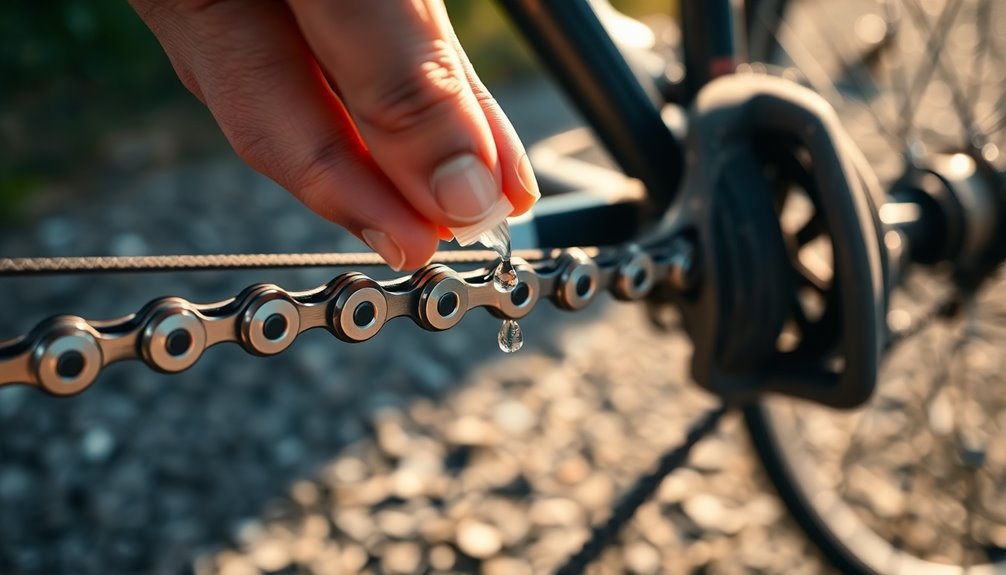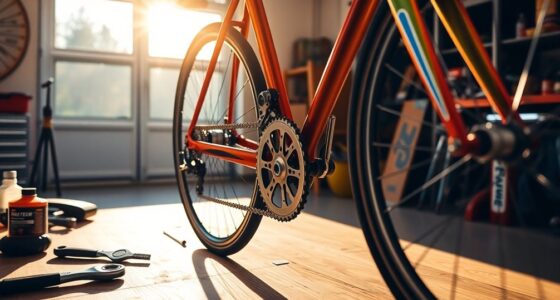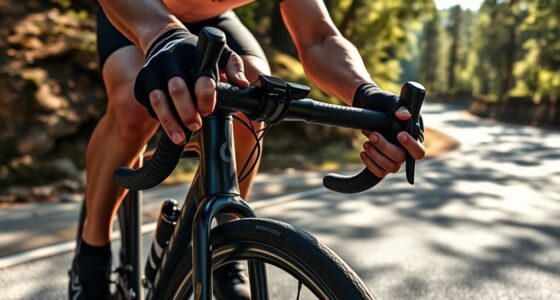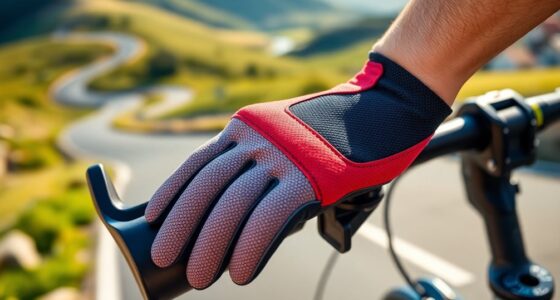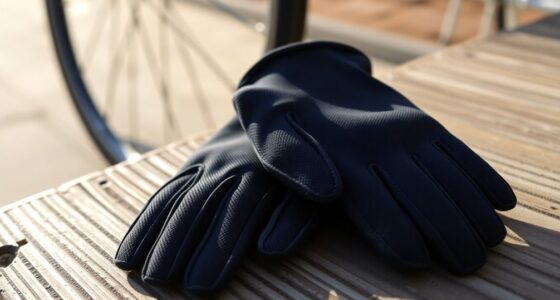To fix a squeaky bike chain, start by thoroughly cleaning it to remove dirt and grime. After cleaning, apply a proper lubricant suited for your riding conditions. Make sure to check for rust or stiff links; if the chain exceeds 12 inches for 12 links, consider replacing it. Don't forget to inspect the derailleur for alignment issues. If squeaking persists, it might indicate deeper problems in your drivetrain, which you can learn more about.
Key Takeaways
- Clean the bike chain using a bicycle-specific cleaner to remove dirt and grime that causes squeaking.
- Lubricate the chain regularly with the appropriate lubricant for your riding conditions to reduce friction and noise.
- Inspect the chain for wear; replace it if 12 links measure over 12 inches or show noticeable wear on one side.
- Ensure the derailleur is properly aligned and check for bent hangers or worn pulleys that may cause misalignment and noise.
- Address any persistent squeaking by checking for mechanical issues or seek professional help if necessary.
Common Causes of a Squeaky Bike Chain
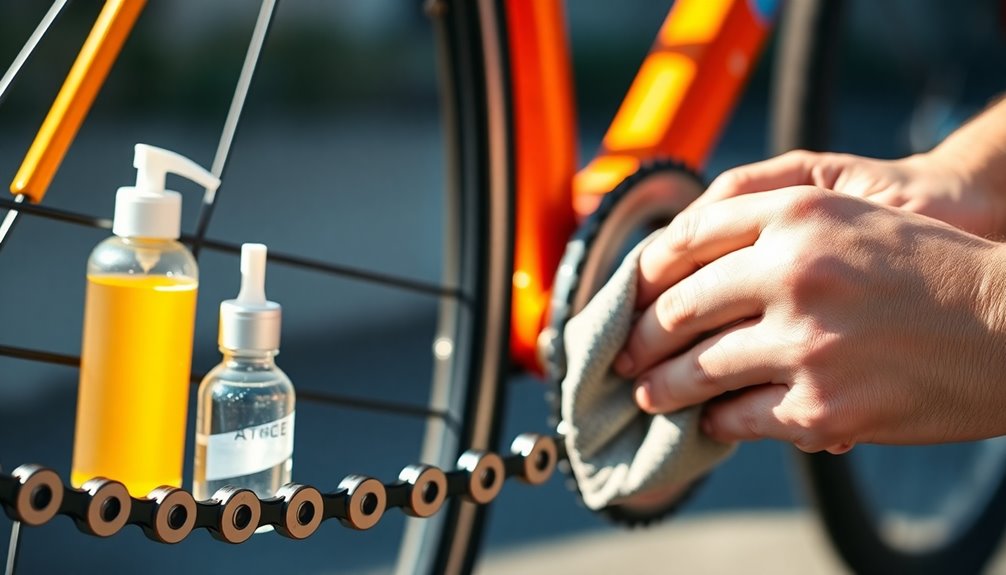
A squeaky bike chain can be frustrating, especially when it disrupts your ride. One of the most common causes of this annoying noise is insufficient lubrication. When dirt and grime build up, they create friction between the chain links, leading to those irritating sounds.
Rust can also be a culprit, particularly if your bike's been exposed to moisture, causing stiffness and more noise. Additionally, if you hear clicking or squeaking while pedaling, it might indicate a misalignment of the derailleur or improper cable tension.
To keep your ride smooth, regularly inspect your chain's wear; if 12 links measure over 12 inches, it's time for a replacement. Addressing these common bike noises can enhance your cycling experience considerably.
Inspecting Your Chain and Drivetrain
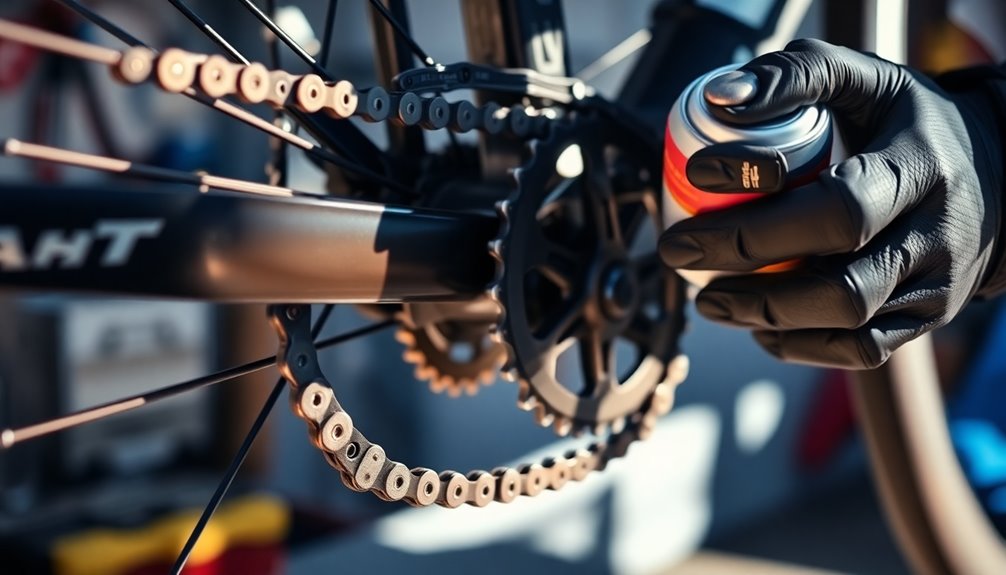
To keep your bike running smoothly, begin by evaluating the condition of your chain.
Look for any rust or stiff links, and make sure the derailleur is properly aligned and lubricated.
This quick inspection can help you catch issues before they lead to more significant problems.
Assess Chain Condition
Inspecting your bike chain and drivetrain is essential for maintaining ideal performance and preventing annoying squeaks.
Start by checking the chain length; if 12 links measure 12 inches, your chain seems to be in good shape. Next, look for stiffness or rust—any signs here may mean it's time for a replacement.
Don't forget to assess your sprockets and derailleur; wear can lead to more noise and shifting issues. Finally, verify your derailleur pulleys are well-lubricated to minimize friction.
Here's a quick checklist:
- Measure chain length for wear.
- Inspect for stiffness or rust.
- Check sprockets and derailleur condition.
- Lubricate derailleur pulleys properly.
Stay proactive to enjoy a smooth ride!
Check Derailleur Alignment
After evaluating your bike chain's condition, it's time to check the derailleur alignment.
Start by inspecting the derailleur hanger; it should be straight and properly aligned. A misaligned hanger can cause your chain to rub against the derailleur, creating those annoying squeaks.
Next, examine the derailleur pulleys for dirt and confirm they're well-lubricated. This helps maintain smooth chain movement and reduces noise.
Don't forget to check the cable tension on the derailleur; improper tension can lead to shifting issues and increase squeaking.
Finally, verify that the derailleur limit screws are correctly set to prevent any chain rubbing.
Regularly clean and lubricate the derailleur's pivot points to keep everything operating smoothly and quietly.
Cleaning the Chain Effectively
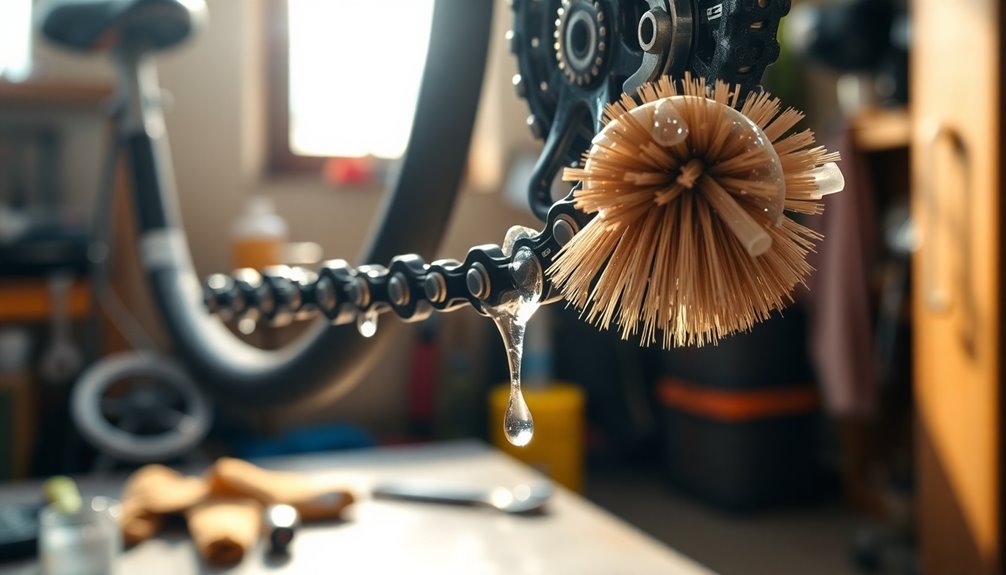
To keep your bike chain running smoothly, you need to clean it properly and apply the right lubrication.
Start by using a bicycle-specific cleaner and tools to remove dirt and rust effectively.
Once it's clean, don't forget to lubricate the chain to guarantee it performs at its best.
Proper Cleaning Techniques
While cleaning your bike chain might seem like a simple task, using the right techniques can make a significant difference in its performance.
To effectively clean your chain, follow these steps:
- Use a cardboard surface to catch drips and keep your workspace mess-free.
- Apply a bicycle chain cleaner like WD-40, avoiding regular WD-40 to prevent damage.
- Slowly rotate the pedal while spraying the cleaner onto the chain for even coverage.
- Finish by wiping the chain with a clean rag to remove excess cleaner and grime.
Effective Lubrication Methods
Once you've cleaned your bike chain, the next step is lubrication, which plays a vital role in maintaining smooth performance.
To guarantee effective lubrication methods, inspect your entire drive train, including the chainrings and derailleur. Apply lubricant to a single spot on the chain while pedaling, allowing it to spread evenly.
Remember to use a bicycle-specific lubricant, as it's designed to protect your chain without causing damage. Regularly lubricate your chain after every 100-150 miles or following wet rides to keep squeaks at bay. Additionally, optimal tire pressure affects overall bike performance, so ensure your tires are properly inflated as well.
Additionally, don't forget to check other drivetrain components for any potential issues. Staying proactive with lubrication will enhance your bike's performance and longevity, keeping your rides enjoyable and smooth.
Choosing the Right Lubricant
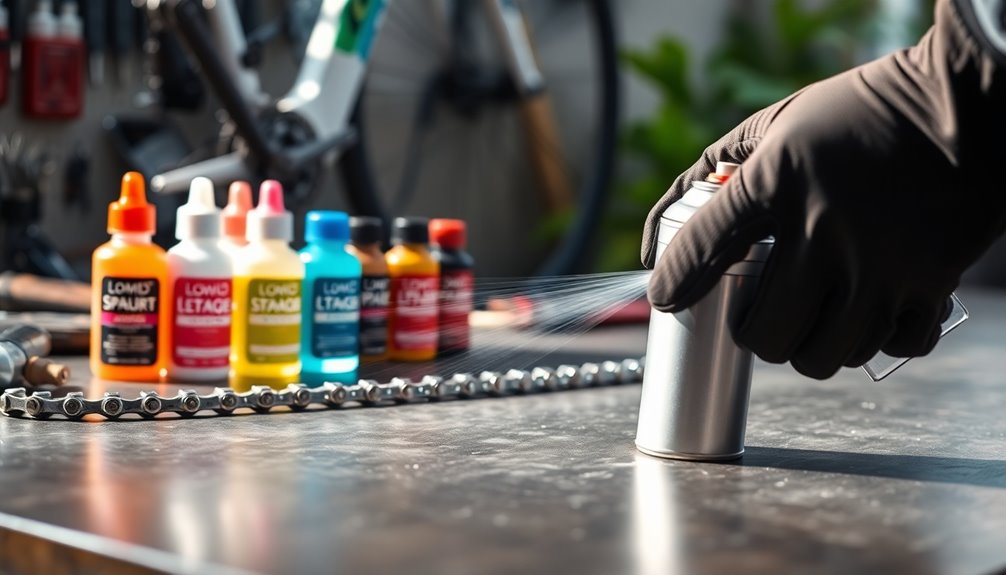
Selecting the right lubricant for your bike chain is essential for smooth performance and longevity. You want a lubricant designed for bicycle chains, as general-purpose options like WD-40 can harm your chain.
Here are some choices to take into account:
- Silicone-based lubricants: Ideal for dry conditions, they repel dirt and grime.
- Wet lubricants: Perfect for wet or muddy environments, offering staying power.
- Wax-based lubricants: Provide a cleaner application and don't attract dirt, especially those made through the hot wax method.
- Regular inspection: Adjust your lubricant based on changing weather and terrain to keep that squeak at bay.
Always verify your chain is clean and dry before applying any lubricant for peak performance!
Proper Lubrication Techniques
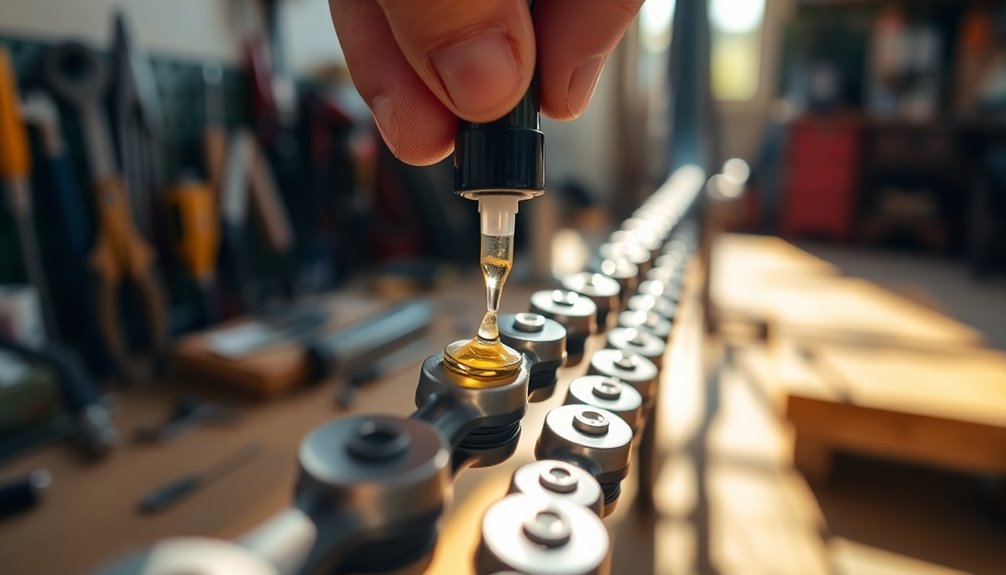
To keep your bike chain running smoothly, you should prioritize regular lubrication.
Implement effective methods like the drip technique to guarantee every link gets the attention it needs.
Chain Lubrication Frequency
Regularly lubricating your bike chain is essential for peak performance and to prevent annoying squeaks.
To keep your chain in top shape, pay attention to the chain lubrication frequency. Aim to lubricate every 100-150 miles, or more often in wet or dusty conditions.
Here are some key points to remember:
- Lubricate after every long ride to maintain smooth operation.
- Check for wear and replace if necessary to avoid squeaking.
- Always use a bicycle-specific lubricant to prevent dirt attraction.
- Allow the chain to dry completely before applying lubricant for better adhesion.
Effective Lubrication Methods
Achieving a smooth, quiet ride starts with effective lubrication methods for your bike chain. First, clean your chain thoroughly and let it dry completely.
A lubricant specifically designed for bicycle chains is essential; apply it while pedaling backward to guarantee even coverage on each link. Remember to wipe off any excess lubricant afterward, as it can attract dirt and grime, worsening noise issues.
For long-lasting results, consider the hot wax method, which offers a cleaner, more efficient alternative to traditional oils.
Regularly check your chain's wear by measuring 12 links; if they exceed 12 inches, it might be time for a replacement.
Following these steps will keep your bike chain running smoothly and quietly.
Checking for Chain Wear and Damage
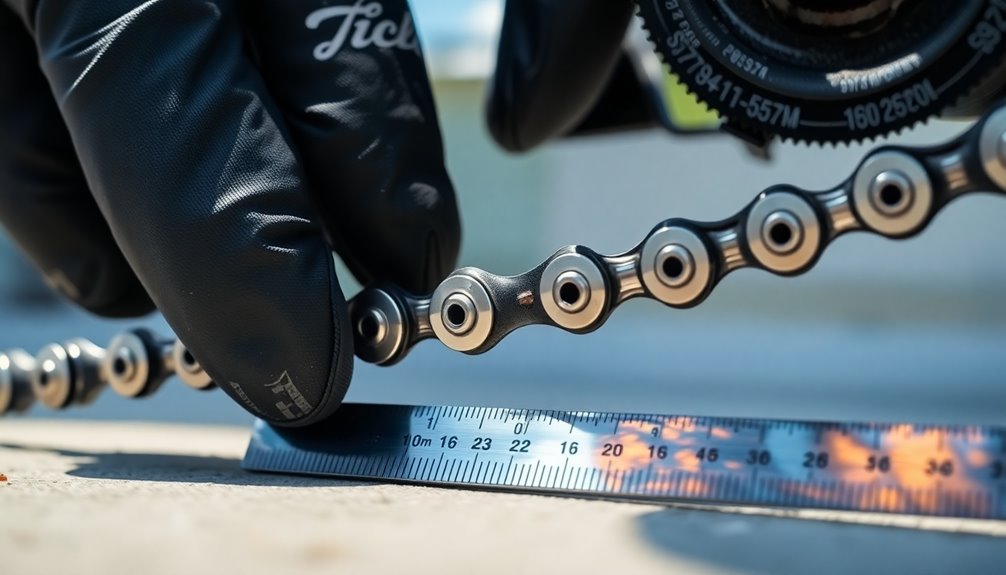
Before you oil your bike chain, it's essential to check for wear and damage that could affect its performance. Regular inspections can save you from costly repairs.
Before oiling your bike chain, inspect for wear and damage to ensure optimal performance and avoid costly repairs.
Here's what to look for:
- Chain Length: Measure 12 links; if it's not about 12 inches, your chain might be worn.
- Stiff Links: Inspect for any stiff links or excessive rust; significant rust means it's time for a replacement.
- Elongation: Look for signs of a stretched chain, which can cause poor shifting.
- Uneven Wear: Check for uneven wear across the links; noticeable wear on one side indicates the need for replacement.
Assess your chain every 300-500 miles to keep everything running smoothly and avoid performance issues later on.
Troubleshooting Derailleur Issues
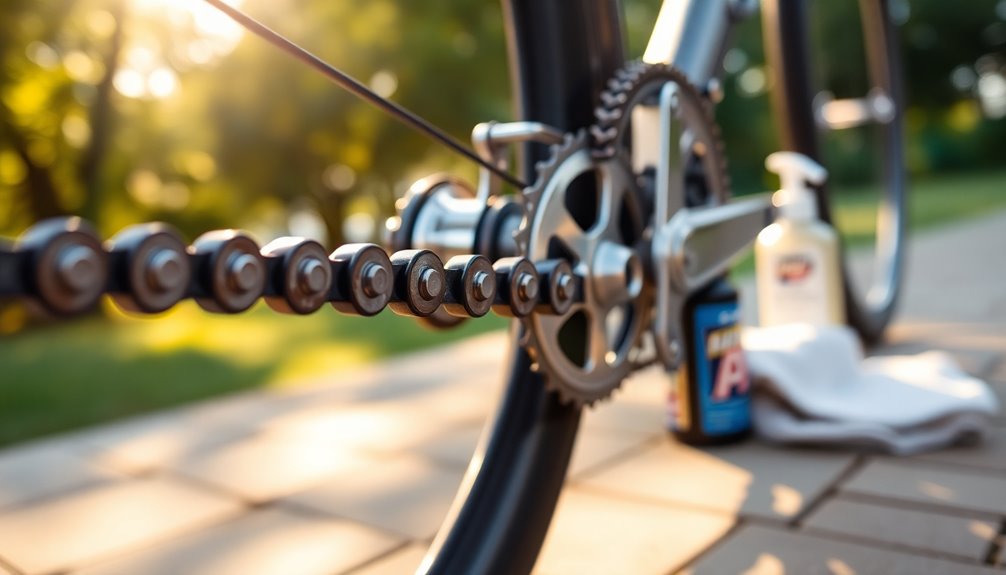
After confirming your bike chain is in good condition, it's time to address any derailleur issues that might be causing that annoying squeak.
Start by checking the derailleur alignment; it should be parallel to the cassette, and the hanger shouldn't be bent. Misalignment can lead to noise.
Next, inspect the derailleur pulleys for dirt or damage, as unmaintained pulleys increase friction and sound.
Adjust the cable tension using barrel adjusters to guarantee smooth shifting and prevent rubbing against the derailleur.
Regularly clean and lubricate the derailleur hinges and pulley wheels to minimize resistance.
Finally, confirm that the derailleur limit screws are properly adjusted to prevent unwanted movement, which can also create noise and wear.
Maintaining Your Drivetrain Components
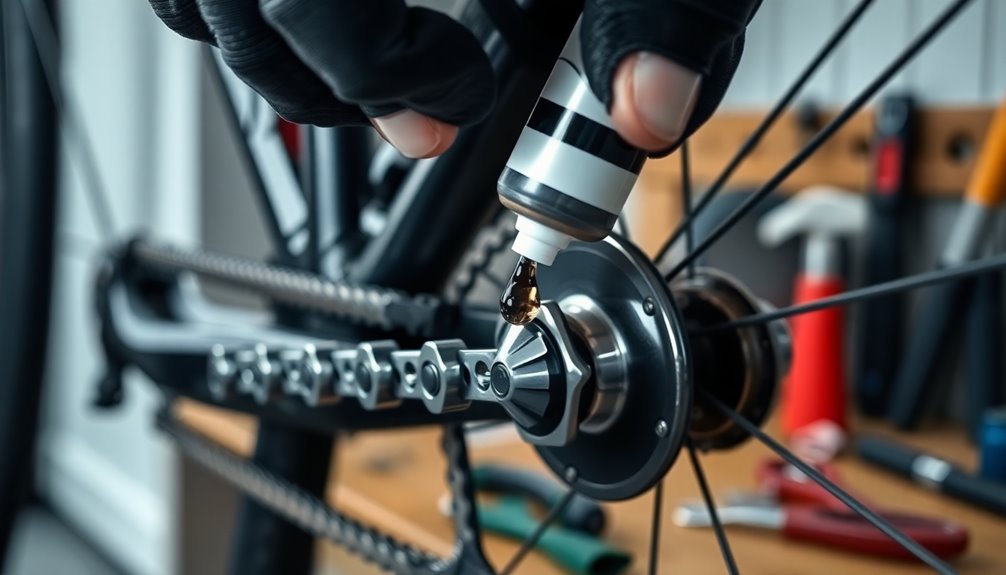
To keep your bike running smoothly, maintaining your drivetrain components is essential. Regular maintenance helps eliminate those annoying squeaks and creaks that can ruin your ride.
Follow these steps:
- Clean and lubricate your chain regularly with specific bike chain products to prevent squeaking.
- Inspect derailleur pulleys for alignment and lubrication; misalignment can lead to noise and poor shifting.
- Measure chain length using the 12 links equals 12 inches method; replace it if it exceeds this to maintain efficiency.
- Check all drivetrain components for wear or damage—chainrings, sprockets, and cassettes can all contribute to noise and performance issues.
Preventive Measures for Squeaky Chains

Maintaining your drivetrain components plays a significant role in preventing squeaky chains. To keep your chain in top condition, regularly clean it with a suitable cleaner—avoid regular WD-40, which can be harmful. Lubricate your chain often, guaranteeing even application and removing excess lube to stop dirt buildup. Store your bike indoors, shielding it from moisture and extreme temperatures to prevent rust. Inspect your chain for wear; if 12 links measure over 12 inches, replace it. Finally, verify all drivetrain components are aligned and maintained to minimize noise.
| Preventive Measure | Benefits |
|---|---|
| Regular cleaning | Reduces dirt and grime |
| Frequent lubrication | Prevents squeaking |
| Indoor storage | Avoids rust and damage |
When to Seek Professional Help
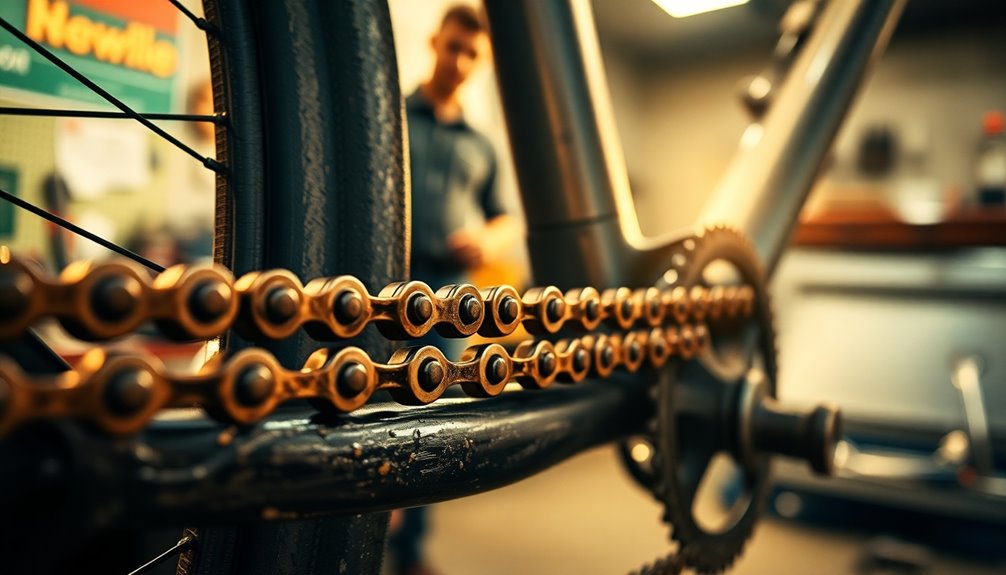
If you've cleaned and lubricated your bike chain but the squeaking continues, it's time to reflect on professional help. A local shop can diagnose issues you mightn't see.
Here are four signs that it's time to seek assistance:
- Persistent Squeaking: If the noise stays after your efforts, there's likely an alignment issue.
- Worn Chain: If your chain stretches beyond 12 inches, replacement is essential.
- Misaligned Derailleur: If the derailleur pulleys aren't aligned, a technician can make necessary adjustments.
- Clunking Sounds: If you hear clunking under load, it signals deeper mechanical problems that need a qualified mechanic.
Don't wait until minor issues escalate; your bike's longevity depends on it!
Frequently Asked Questions
Is It Okay to Use WD-40 on a Bike Chain?
Using WD-40 on your bike chain isn't a good idea.
While it might clean, it strips away necessary oils, causing increased wear on your chain and drivetrain. WD-40 can also leave a residue that attracts dirt, leading to a gummed-up chain.
Instead, opt for specialized bicycle lubricants that penetrate and protect your chain links.
If you've already used WD-40, clean the chain thoroughly and apply a proper bike lubricant for better performance.
Why Does My Bike Chain Creak When I Pedal?
When your bike chain creaks while you pedal, it usually means something's not quite right.
It could be due to insufficient lubrication, dirt buildup, or even rust. You might also be dealing with worn components or misalignment in the derailleur.
If you've been riding a lot, check for wear and consider adjustments.
Regular maintenance is key; cleaning and lubricating your chain will help keep that creaking noise at bay.
What Is Best to Lubricate a Bicycle Chain?
When you're looking to lubricate your bicycle chain, you should choose a lubricant specifically designed for bikes.
Wax-based, dry, or wet lubes work great depending on your riding conditions. Avoid WD-40, as it can damage the chain. A semi-dry silicone-based lube offers solid protection against dirt and moisture.
For the cleanest option, consider hot wax lubrication.
Make sure to lubricate your chain every 100-200 miles to keep it running smoothly!
How to Stop Bike Squeaking?
Imagine your bike's a restless horse, keen to gallop but held back by an annoying squeak.
To calm this steed, start by checking the chain and all components for dirt or grime. Clean them thoroughly, then apply a proper lubricant.
Inspect parts like derailleur pulleys for misalignment. If you hear persistent noise, don't ignore it—your horse might need a little more attention to ride smoothly without the squeaks!
Conclusion
So, you've tackled the squeaky bike chain like a pro, but who knew a little noise could lead to such a grand adventure in maintenance? Ironically, that pesky squeak might just be the best motivator to keep your bike in top shape. By regularly cleaning and lubricating your chain, you not only silence the gremlins but also enhance your ride. After all, who wouldn't want a smooth ride without the serenade of squeaks? Happy cycling!
